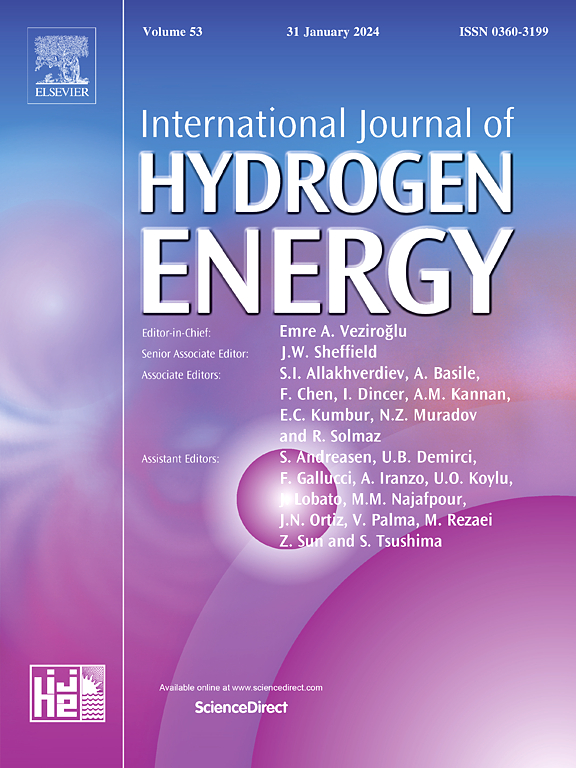N2和CO2对氢混合天然气可燃性极限参数及动力学特性的影响
IF 8.1
2区 工程技术
Q1 CHEMISTRY, PHYSICAL
引用次数: 0
摘要
本研究通过实验、预测模型和化学动力学探讨了氢混合天然气(HBNG)在CO2和N2稀释下的可燃性极限(FL)。采用极限层流火焰速度法,实现了可燃性上限(UFL)预测误差低于3%。实验结果表明,将掺氢比(R)由0.1提高到0.3,可使UFL提高4.165%,下限提高0.98%。动力学分析表明,CO2能显著降低·H、·OH和·O的峰摩尔分数,分别降低87.6%、87.0%和81.3%,而N2的作用较弱。此外,CO2改变了主要的链式反应,抑制了高活化能途径。灰色关联分析发现·OH和氢含量是影响可燃性的最重要因素。这些发现阐明了惰性气体的抑制机制,提高了混合氢燃料可燃性行为的定量预测,为工业应用中的氢安全设计和风险评估提供了有价值的见解。本文章由计算机程序翻译,如有差异,请以英文原文为准。

Effect of N2 and CO2 on the flammability limit parameters and kinetic characteristics of hydrogen-blended natural gas mixtures
This study explores the flammability limits (FL) of hydrogen-blended natural gas (HBNG) under CO2 and N2 dilution using experiments, predictive modeling, and chemical kinetics. A limiting laminar flame speed method is applied, achieving upper flammability limit (UFL) prediction errors below 3 %. Experimentally, increasing the hydrogen blending ratio (R) from 0.1 to 0.3 raises the UFL by 4.165 % and the lower limit by 0.98 %. Kinetic analysis shows that CO2 significantly reduces the peak mole fractions of ·H, ·OH, and ·O by 87.6 %, 87.0 %, and 81.3 %, respectively, while N2 has a weaker effect. Furthermore, CO2 alters dominant chain reactions, suppressing high-activation energy pathways. Grey relational analysis identifies ·OH and hydrogen content as the most influential factors for flammability. These findings clarify the suppression mechanism of inert gases and improve the quantitative prediction of flammability behavior in blended hydrogen fuels, offering valuable insight for hydrogen safety design and risk assessment in industrial applications.
求助全文
通过发布文献求助,成功后即可免费获取论文全文。
去求助
来源期刊

International Journal of Hydrogen Energy
工程技术-环境科学
CiteScore
13.50
自引率
25.00%
发文量
3502
审稿时长
60 days
期刊介绍:
The objective of the International Journal of Hydrogen Energy is to facilitate the exchange of new ideas, technological advancements, and research findings in the field of Hydrogen Energy among scientists and engineers worldwide. This journal showcases original research, both analytical and experimental, covering various aspects of Hydrogen Energy. These include production, storage, transmission, utilization, enabling technologies, environmental impact, economic considerations, and global perspectives on hydrogen and its carriers such as NH3, CH4, alcohols, etc.
The utilization aspect encompasses various methods such as thermochemical (combustion), photochemical, electrochemical (fuel cells), and nuclear conversion of hydrogen, hydrogen isotopes, and hydrogen carriers into thermal, mechanical, and electrical energies. The applications of these energies can be found in transportation (including aerospace), industrial, commercial, and residential sectors.
 求助内容:
求助内容: 应助结果提醒方式:
应助结果提醒方式:


